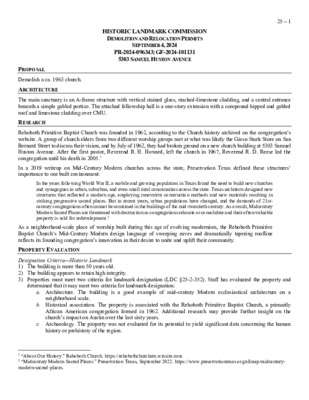25.0 - 5303 Samuel Huston Ave — original pdf
Backup

HISTORIC LANDMARK COMMISSION DEMOLITION AND RELOCATION PERMITS SEPTEMBER 4, 2024 PR-2024-096343; GF-2024-101131 5303 SAMUEL HUSTON AVENUE 25 – 1 PROPOSAL Demolish a ca. 1963 church. ARCHITECTURE RESEARCH The main sanctuary is an A-frame structure with vertical stained glass, stacked-limestone cladding, and a central entrance beneath a simple gabled portico. The attached fellowship hall is a one-story extension with a compound hipped and gabled roof and limestone cladding over CMU. Rehoboth Primitive Baptist Church was founded in 1962, according to the Church history archived on the congregation’s website. A group of church elders from two different worship groups met at what was likely the Giese-Stark Store on San Bernard Street to discuss their vision, and by July of 1962, they had broken ground on a new church building at 5303 Samuel Huston Avenue. After the first pastor, Reverend R. H. Howard, left the church in 1967, Reverend R. D. Reese led the congregation until his death in 2005.1 In a 2019 writeup on Mid-Century Modern churches across the state, Preservation Texas defined these structures’ importance to our built environment: In the years following World War II, a mobile and growing population in Texas found the need to build new churches and synagogues in urban, suburban, and even small rural communities across the state. Texas architects designed new structures that reflected a modern age, employing innovative construction methods and new materials resulting in striking progressive sacred places. But in recent years, urban populations have changed, and the demands of 21st- century congregations often cannot be contained in the buildings of the mid-twentieth century. As a result, Midcentury Modern Sacred Places are threatened with destruction as congregations relocate or consolidate and their often-valuable property is sold for redevelopment.2 As a neighborhood-scale place of worship built during this age of evolving modernism, the Rehoboth Primitive Baptist Church’s Mid-Century Modern design language of sweeping eaves and dramatically tapering roofline reflects its founding congregation’s innovation in their desire to unite and uplift their community. PROPERTY EVALUATION Designation Criteria—Historic Landmark 1) The building is more than 50 years old. 2) The building appears to retain high integrity. 3) Properties must meet two criteria for landmark designation (LDC §25-2-352). Staff has evaluated the property and determined that it may meet two criteria for landmark designation: a. Architecture. The building is a good example of mid-century Modern ecclesiastical architecture on a neighborhood scale. b. Historical association. The property is associated with the Rehoboth Primitive Baptist Church, a primarily African American congregation formed in 1962. Additional research may provide further insight on the church’s impact on Austin over the last sixty years. c. Archaeology. The property was not evaluated for its potential to yield significant data concerning the human history or prehistory of the region. 1 “About Our History.” Rehoboth Church. https://rehobothchurchatx.wixsite.com 2 “Midcentury Modern Sacred Places.” Preservation Texas, September 2022. https://www.preservationtexas.org/allmep/midcentury- modern-sacred-places. d. Community value. The property was not evaluated for its ability to possess a unique location, physical characteristic, or significant feature that contributes to the character, image, or cultural identity of the city, the neighborhood, or a particular demographic group. See b. e. Landscape feature. The property is not a significant natural or designed landscape with artistic, aesthetic, 25 – 2 cultural, or historical value to the city. DEPARTMENT COMMENTS The Rehoboth Primitive Baptist Church, a religious organization under §11.20 of the Tax Code, sold the building to Samuel Huston-Bunche, L.L.C., in February of 2024. Samuel Huston-Bunche, L.L.C., does not appear to qualify as a religious organization under the Tax Code; thus, the 2019 amendment to § 211.0165 of the Local Government Code, exempting religious organizations from owner-opposed designation, do not apply. See the 2021 memorandum to the Historic Landmark Commission on demolition or relocation permit applications for property owned by religious organizations for details. STAFF RECOMMENDATION Consider whether the church meets the architectural and associational significance required for initiation of historic zoning. Should the Commission decide against initiation, release the demolition permit only upon completion of a City of Austin Documentation Package. LOCATION MAP 25 – 3 PROPERTY INFORMATION Photos 25 – 4 25 – 5 Demolition permit application, 2024 25 – 6 Google Street View, March 2024 Occupancy History City Directory Research, August 2024 1963 Under construction 1964 Rehoboth Primitive Baptist Church 1965 Rehoboth Primitive Baptist Church 1970 Rehoboth Primitive Baptist Church 1975 Rehoboth Primitive Baptist Church 1980 Rehoboth Primitive Baptist Church 1985 Rehoboth Primitive Baptist Church 1992 Rehoboth Primitive Baptist Church Historical Information 25 – 7 The Austin Statesman (1921-1973); Austin, Tex.. 06 July 1962: 5. The Austin Statesman (1921-1973); Austin, Tex.. 01 Mar 1970: T27. 25 – 8 The Austin American - Statesman (1973-1980), Apr 26, 1975, Evening ed. About Our History | Rehoboth Church (rehobothchurchatx.wixsite.com) Permits Building permit, 1962 25 – 9 Water Tap Permit, July 24, 1962 Sewer Tap Permit, October 20, 1975